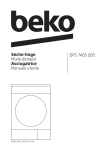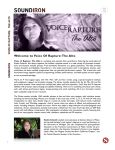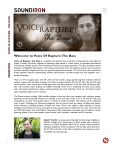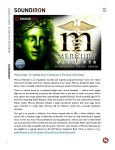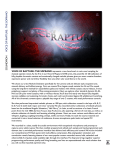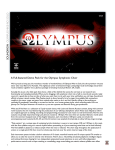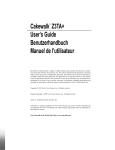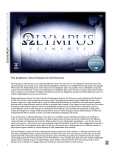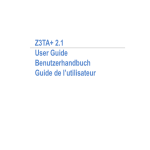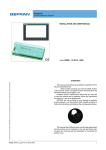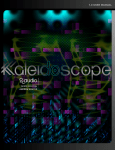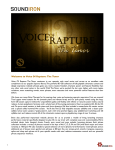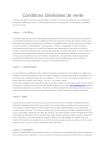Download 1 - s3.amazonaws.com
Transcript
SOUNDIRON MERCURY SYMPHONIC BOYCHOIR version 1.0 We welcome you to the Soundiron Mercury Symphonic Boychoir There is a special sound to a traditional English boy’s choral ensemble — solemn lows, angelic highs and an overwhelming innocence that harkens back to the days of youth and purity. We've truly capture this unique quality with a painstakingly sampled full boy’s choral ensemble (ages 8-13), crafting the single most comprehensive and detailed children's choral ensemble library ever designed. To achieve this, we recorded with the outstanding Pacific Boychoir under the direction of Kevin Fox and conducted by Meastro Robert Geary. Our Mercury Symphonic Boychoir features a pair of masterfully mixed composite microphone positions (stage and hall), carefully blended from an array of 12 discreet large diaphragm Neumann microphones, with wide stereo pairs ranging in carefully spaced distances from 1 meter to 20 meters. We've struck an ideal balance between presence, clarity, richness and atmosphere, returning to the same large crystal-clear open hall in which we recorded our Olympus choirs. Surround mixing is made simple with the best balance between placement, flexibility and performance, without compromising the truly awesome sound these exceptional singers deliver. Our goal is to provide a children’s choir library uniquely able to offer a classic English boychoir sound, with a complete range of utility that would allow it be used as a fully stand-alone naked instrument within a mix, in even the most critical applications, without any need for any additional instrumental or choral accompaniment. We took all of what we learned in the development of our Requiem Light and Olympic Symphonic Choirs and designed our most powerful yet easy-to-use choir library yet. 1 SOUNDIRON MERCURY SYMPHONIC BOYCHOIR Mercury includes a wealth of detailed and flexible content and extraordinary programming, with 42 staccatos & 42 sustaining marcato words, with deep round-robin and stacking/layering options, 18 tempo-syncing Latin poly-syllabic sustains with phrasesynchronous polyphonic legato, unique fff poly-staccatos and 7 dynamic true legato vowels (ah, oh, oo, eh, ee, mm and a classic ensemble whistle legato) with real-time speed control from fluid to tight. In addition to the true legato chorus sustain types, all sustaining articulations include 3-part polyphonic simulated legato. Mercury also includes drone and whispering chants, staccatos and sustains, trills, sweeps, swells and other choral effects. You’ll also find two exquisite soloists (younger soprano and older alto), each with a wide range of poly-syllabic phrases, staccatos and a fluid true legato vowel sustain for each. We've upgraded our adaptive Phrasemaster phrase-building system, which allows you to automatically progress through a sequence of staccato or marcato syllables, advancing to the next one each time you play a new note, with up to 16 sequencable presets that can be arranged, modified and triggered in realtime using automation and key-swithing. We’re also proud to introduce our new Wordmaster system, a powerful marcato/ staccato sequencing tool that let’s you choose from 42 different words for two independent articulation layers and switch them from staccato to sustaining marcato at the push of a button or press of a key-switch. It provides the convenience of instant word-building with the superior quality, realism and reliability of expertly hand-tailored content. This is a professional tool for experienced composers and arrangers that requires a bit of practice and skill to properly and fully utilize. Like any sample-based library, it cannot always truly replace a live choir and it cannot be used to replicate every possible choral arrangement flawlessly. Like any instrument, it does take time to learn and explore, in order to successfully create quality results in a finished piece of music. That said, it is also designed to be a powerful and intuitive tool right out of the box for users who are familiar with and skilled at using complex orchestral sample libraries. It is fully automatable, efficiently scalable, logically designed, completely user-controllable and ultimately customizable. We hope you enjoy the Mercury Symphonic Boychoir! 2 SOUNDIRON MERCURY SYMPHONIC BOYCHOIR SOUNDIRON Mercury Symphonic Boychoir version 1.0 OVERVIEW 77 nki presets (open Kontakt format) 14,605 samples (open wav format) 24bit / 48kHz stereo pcm Powerful custom performance and FX user control interface for Kontakt Note: • The full version of Kontakt 4.2.4 (for default presets) and Kontakt 5.0.3 (all tempo-sync & time-stretch presets) or later is required to use the instrument presets in this library. The Kontakt “Player” and special “Libraries” tab do not support this library. • This product is securely watermarked for each licensed user with the Continuata Watermarking System. CREDITS Produced, Recorded and Engineered by Mike Peaslee, Gregg Stephens and Chris Marshall Additional Programming, Tuning & Beta Testing by Brad Halverson Post Production, Editing, Mixing and Mastering by Gregg Stephens and Mike Peaslee Directed By Robert Geary & Kevin Fox Scripting & Systems Design by Chris Marshall Session Production by Alan Kleinschmidt & Barbara Heroux Programmed by Chris Marshall, Mike Peaslee, Gregg Stephens Performed by The Pacific Boychoir UI Design and Artwork by Constructive Stumblings, Chris Marshall, Gregg Stephens & Mike Peaslee Special Thanks to Jen & Josie, Xenia and Meagan TABLE OF CONTENTS General :: OVERVIEW & CREDITS - Page 3 WORDMASTER - Page 19 PHRASEMASTER - Pages 20 - 21 TECHNICAL INFO - Page 4 SYSTEM REQUIREMENTS - Page 4 Presets :: User Interface :: WORDMASTER - Page 23 MAIN FRONT PANEL - Page 6 - 7 PHRASEMASTER - Page 23 TRUE LEGATO - Pages 23 - 24 INTRODUCTION - Pages 1 - 2 PROGRAM TYPES - Page 22 EQ - Page 7 CONVOLUTION REVERB - Page 8 MARCATO - Page 24 STACCATO - Pages 24 - 25 LEGATO - Page 9 UBBERPEGGIATOR - Page 10 VIBRATO - Page 11 POLYSUSTAINS - Page 25 Main Preset Types:: CHORAL EFFECTS - Page 26 SOLOISTS - Page 25 VOWEL SUSTAINS - Page 26 POLYSUSTAINS - Page 12 Info :: TRUE LEGATO - Page 13 STACCATO - Page 14 LYRICAL ELEMENTS - Page 27 LICENSE AGREEMENT - Page 28 CHORAL EFFECTS - Page 15 THANK YOU - Page 29 MARCATO - Page 16 VOWEL SUSTAINS - Page 17 3 AMBIENCES - Page 18 www.soundiron.com SOUNDIRON MERCURY SYMPHONIC BOYCHOIR ABOUT THIS LIBRARY Fidelity Custom Convolution Impulses This library was recorded in wide stereo at 48kHz / 24bit using 12 discreet large diaphragm microphones in a large a-frame hall. Because of the wooden, stained glass and stone construction and environmental conditions both inside and outside of the recording hall, natural impurities in the sound can and do get into the samples from time to time. We feel this adds to the realism and character of the library. Therefore, please keep in mind that this library isn’t designed to provide perfectly sterile samples. We enjoy capturing the unique acoustic characteristics of spaces and locations that we come across from time to time. Sampling environments is similar to sampling instruments in many ways. It’s done with portable loudspeakers to produce a special sine wave sweep that covers a wide spectrum, from 22 Hz to 22 kHz. We then use dedicated deconvolution software to decode the resulting audio into an impulse response file, which is a wav file with special phase, frequency and timing information embedded in the audio. Format Accessibility Most impulses sound like an odd sort of sharp snap, like a balloon pop or starting pistol fired in the environment that was captured – which is is in fact how impulses used to be made. When loaded into a compatible convolution reverb effect (such as the one built into Kontakt), these impulses impart their sonic properties fairly well into most sounds. Of course, it's an imperfect science and much is lost in the translation, especially if the sound being played through it also has it's own strong tonal, phase or reflective properties. Sometimes the results are incredibly lifelike and just as often, they can be completely surreal. It all depends on the sound, the impulse, the settings you choose. All of the sample content and impulse files are included as standard non-encrypted PCM wav files and standard openformat Kontakt presets to allow you easy access to manipulate, reprogram and customize the sounds however you prefer. We know that it’s important for many users to be able to go beyond the limitations of any one sampler or preset structure, so we’ve kept this library’s directories and files open for advanced users. As a professional, you may have your own workflow or format requirements, and we trust that you'll respect our hard work and won't share this content with anyone who hasn't paid for it. Keep in mind that to use and/or edit the Kontakt presets, you’ll need the full retail version of Native Instruments Kontakt 4.2.4 (K4) or Kontakt 5.0.3 (K5) or later. Please be aware that the free Kontakt “Player” and any other version or form of Kontakt that came bundled with any other library or software product (other than NI’s “Komplete” package) will not support this library. The free Kontakt Player is NOT a full version of Kontakt and cannot load or play standard open-format Kontakt instruments or libraries. Please read all instrument specs and software requirements before purchasing this or any other Soundiron products to see the full list of software requirements, features and format compatibility for each library. We've included a hand-selected collection of impulse files that we think compliment this library’s sound directly built into the GUI. You can load them into most instrument presets by using the Reverb control panel tab and selecting an impulse from the Impulse drop-down menu. You can also manually import any of your own wavs into the Convolution effect within Kontakt’s instrument editor view, down in the Insert Effects module. Just make sure to set the Reverb control to On and Custom to enable convolution impulse wav import and custom preset saving. Be aware that convolution processing can often create powerful and piercing resonances when applied to many audio sources – especially loud sounds that contain strong mid to low frequency harmonic components. While you can reprogram the samples or presets to other formats, we always recommend using Kontakt for best results, since it widely considered the industry standard and easily the most powerful sample programming and playback platform on the market. However, if you wish to convert or reprogram the wav files and instrument presets into any other sampler or softsynth format, be aware that not all settings and properties will translate accurately, reliably or even at all from one instrument or audio format to the next, due to vast differences in standards, behaviors, structures and capabilities that each platform relies on. 4 SOUNDIRON MERCURY SYMPHONIC BOYCHOIR System Requirements Manual Download Please be aware that many instrument and multiinstrument programs in this library are extremely ram/ cpu and hard disk-streaming resource intensive. We highly recommend that you have a 64-bit operating system (Windows or OSX) with at least 4GB of system ram, a quad-core cpu and a 7200 rpm SATA hard disk or better before purchasing this particular Soundiron library. Large sample sets like those found in this library may load slowly and may cause system instability on older machines. If you have any trouble with our Downloader utility or prefer to use your browser or another download manager, log into your personal manual download page on our website, by using the direct link in your download email. Log in using your download code. Or, if you used the downloader originally, but you need to re-install the library manually for any reason at a later time you can always re-use the original rar files. To do that, you'll need Winrar, UnrarX or another full-featured Rar extraction utility to extract and install the library. Please note that Stuffit Expander and Winzip DON’T support many types of common rar files. Download & Installation We provide the Continuata Connect download manager to offer high-speed, reliable and fully automated library downloading and installation. Download and run the latest version for your OS (PC or Mac) before proceeding. You may also need to add special permissions to your security software for the downloader, if it blocks applications from accessing the web. Preset Loading Next, copy-paste your download code from your download email into the Code box in the downloader window. Make sure to leave out any spaces before or after the code. Press the download button and select the location you'd like to download and install the library. It will automatically start downloading the file(s) and then error-check, extract and install the finished library. Once installation is fully complete, you can remove the .rar download files and store them in a safe place as a back-up copy. We always recommend downloading the latest version of our downloader before you begin. The link in your email will always take you to the latest version. These open-format Kontakt presets require the full version of Kontakt. The standard nki presets can be loaded in Kontakt 4.2.4 or later., but please be aware that the special “(T-Sync)” preset includes tempo-syncing features that automatically lock the playback tempo of each word to your project BPM, so it requires Kontakt 5.0.3 or later. The TM Pro time-stretching engine our TStretch and T-Sync presets use is not available in Kontakt 4. The free Kontakt Player and special "Libraries" browser do not support the Kontakt open format at all. Don't move, rename, delete or modify any of the files or folders created during the download until after you see the status message for all files in your download queue display the word "INSTALLED". Please don't close the downloader while it's actively downloading, unless you press the pause button first. To resume downloading, press the Resume button. If you need to resume downloading after closing the downloader, run it again and enter your code and press Download again. Then select the same download/installation location on your computer that you chose originally. If the downloader reports a DL Error or Install error, it will automatically try to download the file again until it successfully downloads and verifies all the data it needs. It’s best to allow it to finish the process before trying to move or access the library data. Please see your download email for more detailed instructions. 5 Once installation is complete, you can browse and load the included .nki presets using the Files or Database tabs in the Kontakt Browser, or through the main File load/ save menu. Please allow presets to finish loading completely before loading a new one. To load these presets into Kontakt, simply load them into the main instruments rack by using the Files or Database menus to browse to the location on your hard drive that you installed this library. Or you can drag-drop the nki files into Kontakt from your Operating system's file browser. The presets will automatically load all of the required samples and GUI images, which are stored as ncw, nkr and nkc files in the Samples folder. You can’t use the Libraries view to load standard openformat Kontakt Instruments like those contained in this library. Only locked “Powered-By-Kontakt” Libraries are visible to that special browser view. The “Add-Library” function does not support this product or any other open-format Kontakt library. This library doesn’t require any special activation process. SOUNDIRON MERCURY SYMPHONIC BOYCHOIR Common Front Panel Controls This instrument has a variety of special front panel performance controls that allow deep real-time performance customization. You can see each control’s internal midi CC assignment by hovering your mouse over many of the controls and looking down at the “hint” text displayed in the Info bar at the bottom of Kontakt. To turn on the Info bar, press the “i” button at the top of Kontakt. To assign midi CC automation to any knob, simply right-click (PC) or Command-Click (Mac) on the knob and then click the Assign Midi CC button that appears. The next midi controller you move will automatically be assigned to the control.You can access more automation features in the “Auto” tab window on the left side of Kontakt. Or, you can also "drag-drop" controller and host automation numbers from the "Auto" browser on the left side of Kontakt onto this or any of the other automatable controls to lock a control to a host or midi CC envelope. Once assigned to a controller, you can adjust the automation behavior for each controller down at the bottom of the "Auto" automation browser window. After customizing any of the controls, you can save your own custom presets by using the File Save/Load menu at the top of Kontakt. Just choose a new preset name and save it in the same Instrument folder location to insure that Kontakt can locate all necessary files the next time you load it. All custom control knob settings will be saved with the instrument preset. Mic Position Controls You can control the mix volume for each mic position (close and far) by adjusting the Mic Mixer sliders in the upper left corner of the GUI. The C slider controls the Close mix volume and the F slider controls the Far mix volume. To disable and unload one of the mic positions, click the small radio button below the slider. This will conserve memory and voices when you don't need both mic positions at the same time. Effects Panel Controls At the upper left of the UI there are a variety of controls that allow users to customize effects and options. Pressing the ‘name’ of the effect -- such as “Legato,” “Reverb,” or “EQ” -- opens a panel with adjustable options for that effect. The small radial button next to the pop-up button are used to toggle the effect on and off. Layer 1 & 2 Selection Menus Many presets allow for two simultaneous and independent performance layers, allowing you to play back two different articulationss at the same time and adjust each one differently as you wish. For example, one can select the poly-sustain for each layer by clicking the Chant 1 and Chant 2 drop-down menus and selecting from the list of available chants. To conserve voices or when you don't need both layers, you can disable either layer by pressing the small button to the side of each drop-down menu. This will also darker the control area of the disabled layer. Blend Controls In presets with 2 Layers there is an included Blend functionality. When active, the Blend Slider (or CC94) can be used to crossfade between both layers (if both layers are active). The small radial button next to the Blend Slider can be used to enable and disable this functionality. When disabled, both Layers will play overtop of each other. Key Switches. Many presets feature Keyswitch functionality which allows users to quickly switch each layer’s (in 2-Layer presets) or the active articulation by pressing keys on a Midi keyboard. The position of Keyswitches can be customized by adjusting the value in the note names field or by pressing the “SET” button then pressing a key on a Midi keyboard. Keyswtiches can also be disabled completely by toggling the small radial button next to the note range. Be aware that Keyswitches take precedence over playing a sample, so if there is overlap between the playable range and Keyswitches the keyswitch will activate and no sound will play. Key Range You can adjust the playable note range for the choir by using the Key Range controls down at the bottom. This determines the overall interval that the choir can sing at. We use C3 as middle C to match our other choral libraries, so the choir's natural default range for this library is from A#2 up to C5. However, you can artificially extend the range all the way down to a subsonic C-1 and all the way up to a shrill chirping C7 if you wish. One can set the upper and lower range boundaries in two ways: changing the value in the value edit box or pressing the corresponding “SET” button then pressing a key on the midi keyboard. Users can reset the key range to the choir’s natural range by CTLR+Left Clicking on the “Key Range” label. Swell (CC72 & CC73) The Swell knob allows smooth dynamic volume adjustment of the respective Layer from a low pp to a high ff. 6 SOUNDIRON MERCURY SYMPHONIC BOYCHOIR Attack (CC74 & CC75) The Attack knob shapes initial note attack to make the start of each note harder or softer. When used in conjunction with the “Offset” knob, this can be used to create some interesting pad-like effects. Please note the functionality of this knob varies between preset types. See each preset type’s respective page for details. Offset (CC78 & CC79) The Offset knob sets the playback start position of the sample. Please note the functionality of this knob varies between preset types. See each preset type’s respective page for details. Release (CC76 & CC77) The Release knob sets the room decay time of the release sample after a note is released. Higher values represent a larger room, while smaller values can produce an almost dry sound. Rel Vol (CC90 & CC91) The Rel Vol knob controls the volume of release samples only. This can be used to fine-tune how loud or quiet the room decay is when a note is released. To turn of playback of release samples altogether, use the small radial button next to the Rel Vol label. Pan The Pan slider stereo pans samples left or right. EQ Controls The EQ tab contains a full three-band equalizer. This special panel can be found in all of the instrument presets. You'll find this control window at the top right corner of the GUI. To open the window, click the EQ label. To close it, click the label again or click the tab arrow on the right side of the pop up. To enable the EQ effect in the signal path, click the small radio button next to it. EQ3 On/Off This button enables/disables the 3-band Parametric EQ. Mid BW This knob sets the bandwidth for the Mid band. Bass Gain This knob sets the amount of gain for the bass frequency band. Mid Freq. This knob sets the frequency for the mid band. Mid Gain This knob sets the amount of gain for the mid frequency band. 7 Treble Gain This knob sets the amount of gain for the treble frequency band. SOUNDIRON MERCURY SYMPHONIC BOYCHOIR Convolution Reverb Controls We’ve incorporated our custom convolution impulses into each instrument preset, with full control over all available convolution effect parameters. You'll find this control window at the top right corner of the GUI. To open the window, click the REVERB label. To close it, click the label again or click the tab arrow on the right side of the pop up. To enable convolution reverb processing in the signal path, click the small radio button next to it. Convolution On/Off This button enables/disables the convolution reverb effect. High Pass Sets the high frequency cut-off of the impulse response, allowing you to remove rumble and low end. Custom On/Off Turning this button “On” allows for custom impulse loading. It bypasses the ability to load any of our provided impulses so users can save custom presets with custom impulses. Delay Sets the amount of pre-delay time before the wet signal is returned Dry Sets the amount of dry gain (+/-) that is passed through the effect. Wet Sets the amount of wet gain (+/-) that is passed through the effect. Size Sets the simulated room size of the convolution. Low Pass Sets the low frequency cut-off of the impulse response, allowing you to dull and darken the sound. 8 Impulse menus These menus allow you to select from a wide variety of custom convolution reverb impulses that we've personally captured or created for you, separated into experimental FX impulses and simulated real-world spaces. FX This menu allows you to select one of our special effect convolutions. Selecting an impulse from this menu overrides and unloads any currently loaded impulse from the Spaces menu. Spaces This menu allows you to select one of our real-world environmental convolutions. Selecting an impulse from this menu overrides and unloads any currently loaded impulse from the Effects menu. In the example above, “Cath M” stands for the “Cathedral Medium” room impulse. SOUNDIRON MERCURY SYMPHONIC BOYCHOIR Legato Controls This simulated legato system allows you to tie notes together as you play an uninterrupted melody. In natural instruments, notes blend together slightly as a performer changes between pitches. This creates a natural smoothing effect. In complex poly-phonetic and multi-syllable content like the Polysustains, this effect is simulated to give them a more life-like quality. You'll find this system in most presets in Mercury. In the “True Legato” vowel-only sustain presets, an actual recorded interval sample is played that ties the notes together. In simulated legato presets like the Polysustains, the pitch transition is simulated, but all of the other controls appear and function in essentially the same way. As a special added feature for the polysustains, the sequence of syllables will continue fluidly as you play your legato melody. For best results, try to place your note transitions close to syllable transitions. Those might more natural note transition points. For example, you could play “Agnus Dei” on an A and hold the entire phrase out on the same note, or you could play the first syllable “Ah” on the A and then “gnus” at the D below it and then finally transition up a step to E for the last syllable “Dei” and hold it for awhile of even continue playing legato transitions as the vowel sustains. You'll find this control window at the top right corner of the GUI. To open the window, click the Legato label. To close it, click the label again or click the tab arrow on the right side of the pop up. To enable legato, click the small radio button next to it. To play legato transitions, enable the legato system by turning on the radio button next to the Legato label. Then, play a single note and hold it. Now play a new note close to it on the keyboard without letting go of the old note until the new note has started. This short time overlap tells the program that you wish to perform a legato transition instead of releasing the old note and starting the new note. You can play up to three simultaneous melodies at once as long as each melody does not cross into the range of another melody. Polyphony This knob controls the available number of separate legato positions. Using this allows for up to three separate legato melodies to be played simultaneously. Bend This knob (only present in presets with simulated legato) controls the intensity of the simulated legato bend. Setting this knob to 0 turns the bend off completely. Range This knob controls the interval range within which a legato transition will occur. When used with Polyphony, any legato transition played greater than this setting will trigger another legato position. Interval Vol This knob (only present in presets with true legato) controls the volume of the interval samples only. Use this to fine-tune the volume and presence of the real recorded legato transitions. Higher speed settings tend to sound better with slightly lower Interval Volume settings. Speed In presets with simulated legato, the Speed knob controls the speed of the pseudo-legato pitch bend when it is enabled. When turned all the way down, the bend is slow; turned all the way up, the bend is fast. In True Legato presets, this knob controls the speed of the real recorded legato. Slower legato speeds sound the smoothest, but if you want to play faster melodies, we recommend using higher speed settings. 9 Legato On/Off This button toggles legato mode on/off. It is the radio button located to the right of the Legato tab label button. SOUNDIRON MERCURY SYMPHONIC BOYCHOIR Uberpeggiator Controls The staccato and short marcato presets in this library features a flexible, custom arpeggiator system to expand the instant creative potential of some of the presets. It includes automatable performance controls that shape all aspects of the arpeggiator. When used normally, pressing a key causes the note to self-repeat as long as a key is held down. If additional notes are played, it adds them to the sequence of repeats in various ways, depending on the settings you choose and can be used to produce complex melodic chains, plucking patterns and other effects. Mode This knob controls the Arpeggiator mode. Choosing Off disables the Arp system entirely. • On sets it to respond only while a note is pressed., cycling through all held notes as it arpeggiates. • Hold sets it to automatically sustain one note at a time, (monophonic) so that changing keys changes the note that is repeating. • Hold +- sets it to allow new notes to be added to the automated chain of repeats. • EZ-Roll sets it to allow polyphonic rolls to be played. Note Order Menu This drop-down menu allows you to select any number of simple or complex cycle patterns that the arpeggiation will follow as it plays through the sequence of notes you have triggered. Choosing “As Played” will cause it to follow the original order you played the notes in, with the newest note always added to the end of the chain. Higher/Lower This toggles the arpeggiation direction up or down the scale if the Contrain mode is active. Velocity Graph Sequencer This graph allows you to draw the velocities that you want each step in your arpeggiation sequence to play at. Reset (“X”) This button resets all steps in the graph to a default value of 0 (blank). As Played / Table This activates the Graph. When active, the arpeggiation follows the velocities that you’ve drawn on the graph from left to right. When it is bypassed, each note is played at the velocity that it was originally played at. This button is the circle with 3 bars located just to the right of the Reset X button. Duration This knob allows the user to fine-tune the length of each note. Using this, one can shorten the note to staccato-like pulses or extend them beyond the normal beat length. Repeat Setting This sets the direction of the up or down repeats. Rhythm This sets the speed of arpeggiation, as measured in musical time, ranging from whole bars to 128th notes. Fast settings can yield interesting results, but keep in mind that the faster the speed, the more voices you use. Free/Constrain Button Limits and adjusts any new note to the currently selected scale and key. Swing This sets the amount of rhythmic offset (swing) between notes.Values below zero cause the notes to play ahead of the beat.Values above zero cause the notes to play after the beat. Hits and Hit % Knobs Sets the number of repeats of each note BEFORE moving on to the next note in the arp sequence, and Hit % sets the intensity fall-off rate for each repeat, before resetting for the next note. 10 Random This knob humanizes the velocity and timing of each Uberpeggiator step. Steps This setting determines the number of sequencer steps (2 - 32) that can be set with the velocity graph step sequencer. This small stair-step icon is located directly to the right of the Player/Table button. Key Selector Knob Binds the arpeggiation scale you’ve chosen to a specific key. Scale Selector Control binds the arpeggiation sequence to a specific scale that you can choose by turning the knob. SOUNDIRON MERCURY SYMPHONIC BOYCHOIR Simulated Vibrato Controls This simulated vibrato system allows you to subtly create the impression of choral vibrato in some vowel sustain presets, with mild pitch and dynamic oscillation with depth and speed that can be shaped and automated to fit your needs. This is not intended as a replacement for natural vibrato, but when used with care, it can augment and enliven your arrangement. Intensity This knob controls the intensity and depth of the vibrato oscillation effect. Speed This sets the speed of the vibrato oscillation effect. Vibrato On/Off This button toggles Vibrato mode on/off. It is the radio button located to the right of the Vibrato tab label button. 11 SOUNDIRON MERCURY SYMPHONIC BOYCHOIR Main Preset Types Mercury contains a variety of main preset types. Each contains a powerful user interface that allows for full control over the sound. The following section contains descriptions of each preset type and usage information about any controls it might contain. Polysustains Polysustains are the more linguistically complex multi-syllabic part of the library, based on classic Latin words commonly found in liturgical choral music. "Polysustains" are multi-syllable words that hold a sustaining vowel and then play the final syllable when the note is released. You can play polyphonic legato passages with them, with syllable progression maintained through the sustain as you play a melody, or you can restart the word with each new note you play. For example, instead of just singing an "Ah" vowel, a polysustain could be something like "Ha-lle-lu-jaah" where that last syllable "ahh" will continue to hold a long as you continue holding the note down.You can play chords and with legato just as you would a traditional vowel sustain, but it brings more life to the performance. Polysustains come in three varieties: slow, fast and solo. The slow and solo polysustains have a natural tempo of 100 BPM, but there are Tempo-Sync variations that sync each polysustain to the host tempo. Fast polysustains work similarly but were recorded at 140 BPM with a faster, more intense cadence and dynamic level. Polysustain Presets are dual-layer presets. Each Layer has independent controls for shaping the sound. Mic Mixer Controls the levels of each mic position individually, as well as loading and unloading the samples as desired. See Page 6 for more information. Offset (CC78 & CC79) Offset starts playback further into the sample. This can be used to skip to start at different syllables in each polysustain. A value of 100 starts playback at the beginning of the final syllable. A value of 127 starts playback at the pure vowel sustain, so that you can quickly switch between lyrical and pure vowel sustains within the same preset. Effects Panel Controls These buttons in the top-right corner control the various effects available for the preset. See Pages 7-9 for details. Chant 1 & 2 Layer Selector Selects the active polysustain for each Layer. Use the radio button next to each dropdown to disable that Layer completely. Assign a midi controller to the “Chant 1” or “Chant 2” labels above the drop-down menu to automate polysustain selection for each Chant layer. Blend The Blend slider (CC94) controls the crossfade between the Layers when active. Disable the Blend functionality completely using the small radio button next to it. Use this to create new word and phrase combinations by morphing between two separate polysustains. Key Range Sets the choir’s playable note range. See Page 6 for details. Attack (CC 74 & CC75) This control softens and hardens the initial note attack. See Page 7 for details. Rel Vol (CC90 & CC91) Rel Vol controls the volume of release samples only. These samples can be disabled completely using the small radio button next to the label. Keyswitches Select the active Chant for each layer quickly using your midi keyboard. See Page 6 for details. Swell (CC72 & CC73) Swell controls the natural dynamic volume swell. See Page 6 for details. 12 Release (CC 76 & CC 77) Release controls the amount of room decay for the release samples. See Page 7 for details. Legato Polysustain presets feature a custom simulated legato system that allows for melodic lines that follow the different syllables of each polysustain. This included a simulated bend to help the note transitions. See Page 9 for details. SOUNDIRON MERCURY SYMPHONIC BOYCHOIR True Legato True legato involves recording the actual gliss transition between notes as the singers legato between pitches. Our custom system intelligently plays these samples back as the user legatos through a melodic passage. Each True Legato preset is a dual-layer preset that allows vowel morphing by crossfading between layers. In “True Legato Master” the legato vowel for each layer is selectable. There are also static legato patches that do not have selectable layers but allow morphing between two static vowels. This is meant to provide legato functionality to users with less powerful systems or want less overhead. A variant is included so every combination of legato vowels -- of which there are 5 (Ah, Ee, Eh, Mm, Oh and Oo) -- is available. We’ve included versions of True Legato for Kontakt 4 and Kontakt 5. The difference between them is how the “Speed” control of legato works. Kontakt 5 versions utilize the built-in Time Machine Pro engine to actually stretch the interval sample. This allows for slower and quicker legato than Kontakt 4 but Time Machine Pro can cause some audio artifacting and is CPU-intensive. Hint - Playing a legato phrase with True Legato requires a bit of elegance. When playing a legato transition, keep the previous note held down for a brief moment while you press the new note in order to trigger the transition. Mic Mixer Controls the levels of each mic position individually, as well as loading and unloading the samples as desired. See Page 6 for more information. Offset (CC78 & CC79) Offset cuts into the attack samples to produce a harder initial note attack at higher values. Release (CC 76 & CC 77) Release controls the amount of room decay for the release samples. See Page 7 for details. Effects Panel Controls These buttons in the top-right corner control the various effects available for the preset. See Pages 7-9 for details. Chant 1 & 2 Layer Selector The selectors (only in True Legato Master) select the active legato vowel for each layer. The radio buttons next to each dropdown enable/disables each layer. In the static vowel patches, these buttons also load and unload the samples to save on memory Blend The Blend slider (CC94) controls the crossfade between the Layers when active. Disable the Blend functionality completely using the small radio button next to it. Attack (CC 74 & CC75) Attack softens and hardens initial note attack. In True Legato presets this controls the volume of attack samples. Keyswitches Select the active Vowel for each layer quickly using a keyboard. See Page 6 for details. *Only available in True Legato Master. Key Range Sets the playable range. See Page 6 for details. Swell (CC72 & CC73) Swell controls the natural dynamic volume swell. See Page 6 for details. 13 Rel Vol (CC90 & CC91) Rel Vol controls the volume of release samples only. These samples can be disabled completely using the small radio button next to the label. Legato True Legato presets contain controls to set legato options including range and polyphony. Also included is an “Interval Vol” knob that controls the volume of only the legato transition samples. See Page 9 for details. SOUNDIRON MERCURY SYMPHONIC BOYCHOIR Staccato Staccatos are intense, quickly sung notes followed by room decay. Mercury includes 42 different staccatos each with 4x round robin. Staccato presets are single-layer presets that allow for quick selection of a staccato word and customizable sound-shaping. We’ve included Kontakt 5 variants of our staccato presets which include a “speed” control knob that can be used to lengthen of tighten up the staccatos. This feature utilizes Kontakt 5’s built-in Time Machine Pro engine and as such the more extreme settings can produce undesirable results. The Staccato presets are single layer presets but offer a variety of controls to make it truly versatile. Mic Mixer Controls the levels of each mic position individually, as well as loading and unloading the samples as desired. See Page 6 for more information. Offset (CC78) Offset moves the start of sample play back further into the sample. Release (CC 76) Release controls the amount of room decay for the staccatos. See Page 7 for details. Effects Panel Controls These buttons in the top-right corner control the various effects available for the preset. See Pages 7-9 for details. Word Grid The Word Grid shows al 42 available staccatos. Simply click on a word to make it active, as indicated by the “1” that appears next to it. Users can automate grid selection using the “Word” knob described below. Keyswitches The configurable red keyswitches displayed on Kontakt’s internal keyboard can be used to jump immediately to and make active the corresponding word. Key Range Sets the playable range. See Page 6 for details. Word Knob This knob also changes the active word. This knob is intended to be automated via a midi cc. The active word is displayed in red next to this knob as well as on the word grid. Double This button enables staccato doubling. This causes two round robin to play for each note pressed, producing a fatter sound. Swell (CC72) Swell controls the natural dynamic volume swell. See Page 6 for details. Uberpeggiator Staccato presets are the only preset type to include Uberpeggiator functionality. This allows for tempo-synced arpeggiation. See Page 10 for more information. Attack (CC74) Attack softens and hardens initial note attack. Speed (CC95) This knob -- only available in the “T-Stretch K5” variant -utilizes Time Machine Pro to allow users to stretch and compress the length of staccatos. 14 SOUNDIRON MERCURY SYMPHONIC BOYCHOIR Choral FX The Choral Effects preset includes a wide variety unique FX content we captured while recording Mercury. All of our miscellaneous effects -- sustaining clusters, a wartime bomb explosion, swells and of course flatulence -- are in this patch. This is a single-layer preset that functions very much like our Staccato and Marcato Sustains presets. Though similar to the way our Staccato presets function, the samples in the FX preset are available stretched across the keyrange (tuned) or in a special one-note-per-key untuned group. Mic Mixer Controls the levels of each mic position individually, as well as loading and unloading the samples as desired. See Page 6 for more information. Attack (CC74) Attack softens and hardens initial note attack. Offset (CC78) Offset moves the start of sample play back further into the sample. Effects Panel Controls These buttons in the top-right corner control the various effects available for the preset. See Pages 7-9 for details. Word Grid The Word Grid shows all 30 available FX. Simply click on a word to make it active, as indicated by the “1” that appears next to it. Users can automate grid selection using the “Word” knob described below. Each effect has its samples stretched across the keyrange to allow for creative uses except the special “Spoken” and “*All*” groups. These are untuned, onenote-per-key groups that make every effect useable at once. Word Knob This knob also changes the active word. This knob is intended to be automated via a midi cc. The active word is displayed in red next to this knob as well as on the word grid. Swell (CC72) Swell controls the natural dynamic volume swell. See Page 6 for details. Release (CC 76) Release controls the amount of room decay for the staccatos. See Page 7 for details. Rel Vol (CC90) Some effects are looping sustains and as such as release samples. Rel Vol controls the volume of release samples only. These samples can be disabled completely using the small radio button next to the label. Keyswitches Since the sheer amount of FX makes a separate keyswitch for each prohibitive, keyswitches in staccato presets function differently. In these patches there are only two keyswtiches. The lower one moves to the previous word, the upper one moves to the next word. Key Range Sets the playable range. See Page 6 for details. Speed (CC95) This knob -- only available in the “T-Stretch K5” variant -utilizes Time Machine Pro to allow users to stretch and compress the length of the FX. 15 SOUNDIRON MERCURY SYMPHONIC BOYCHOIR Marcato Mercury features 42 unique sustaining marcatos and 28 true, short marcatos. All presets of this type are single-layer presets and the controls throughout are similar, the main difference being the looping sustains and the short, 1-shot true marcatos. Controls for both Marcato preset types are similar but each has a few unique features. Mic Mixer Controls the levels of each mic position individually, as well as loading and unloading the samples as desired. See Page 6 for more information. Offset (CC78) Offset moves the start of sample play back further into the sample. In the “Short” presets this can be used to produce very short, staccato like sounds. Effects Panel Controls These buttons in the top-right corner control the various effects available for the preset. See Pages 7-9 for details. Release (CC 76) Release controls the amount of room decay for the staccatos. See Page 7 for details. Word Grid The Word Grid shows all available Marcatos (42 in the sustaining preset and 28 in the short). Simply click on a word to make it active, as indicated by the “1” that appears next to it. Users can automate grid selection using the “Word” knob described below. Rel Vol (CC90) *Sustaining Only Some effects are looping sustains and as such as release samples. Rel Vol controls the volume of release samples only. These samples can be disabled completely using the small radio button next to the label. Word Knob This knob also changes the active word. This knob is intended to be automated via a midi cc. The active word is displayed in red next to this knob as well as on the word grid. Swell (CC72) Swell controls the natural dynamic volume swell. See Page 6 for details. Speed (CC95) This knob -- only available in the “T-Stretch K5” variant -utilizes Time Machine Pro to allow users to stretch and compress the length of the FX. Key Range Sets the playable range. See Page 6 for details. Uberpeggiator *Short Only Staccato presets are the only preset type to include Uberpeggiator functionality. This allows for tempo-synced arpeggiation. See Page 10 for more information. Legato *Sustains Only The Marcato Sustains presets feature a custom simulated legato system. This included a simulated bend to help the note transitions. See Page 9 for details. Attack (CC74) Attack softens and hardens initial note attack. 16 Keyswitches The configurable red keyswitches displayed on Kontakt’s internal keyboard can be used to jump immediately to the corresponding word. SOUNDIRON MERCURY SYMPHONIC BOYCHOIR Vowel Sustains This special patch contains only the pure vowels -- Ah, Ee, Eh, Ei, Mm, Oh and Oo -- in a dual-layer preset with true p & f layering. This also features a special simulated vibrato system as well as simulated legato. Controls for Vowel Sustains are similar to True Legato with the exception of a new “Pad Mode”. Mic Mixer Controls the levels of each mic position individually, as well as loading and unloading the samples as desired. See Page 6 for more information. Release (CC 76 & CC 77) Release controls the amount of room decay for the release samples. See Page 7 for details. Rel Vol (CC90 & CC91) Rel Vol controls the volume of release samples only. These samples are disabled completely when “Pad” is on. Effects Panel Controls These buttons in the top-right corner control the various effects available for the preset. See Pages 7-9 for details. Vowel 1 & 2 Layer Selector The selectors select the active vowel sustain for each layer. The radio buttons next to each dropdown enable/disables each layer. Assign a midi controller to the “Vowel1” or “Vowel 2” labels to automate each dropdown. Blend The Blend slider (CC94) controls the crossfade between the Layers when active. Disable the Blend functionality completely using the small radio button next to it. Swell (CC72 & CC73) Swell controls the natural dynamic volume swell from pp to ff. See Page 6 for details. Attack (CC 74 & CC75) Attack softens and hardens initial note attack. In True Legato presets this controls the volume of attack samples. Keyswitches Select the active Vowel for each layer quickly using a keyboard. See Page 6 for details. Key Range Sets the playable range. See Page 6 for details. Legato The Vowel Sustains presets feature a custom simulated legato system. This included a simulated bend to help the note transitions. See Page 9 for details. Vibrato The Vowel Sustains presets feature a custom simulated vibrato system. This can help bring the sounds to life. See Page 10 for details. Offset (CC78 & CC79) Offset cuts into the attack samples to produce a harder initial attack at higher values. 17 Pad Mode These buttons turn the corresponding layer into choral pads. Having this enabled disables the attack and release samples for that layer. when in Pad Mode, the Attack and Release controls directly control the envelope shape of the sustain, with a more extreme range of fade times on note start and release. SOUNDIRON MERCURY SYMPHONIC BOYCHOIR Ambiences This preset contains a wide selection of ambient atmospheric material we created from the source content. Ambience controls are very similar to Vowel Sustains with exception of an added “Step” knob and the removal of a “Pad” mode. Effects Panel Controls These buttons in the top-right corner control the various effects available for the preset. See Pages 7-9 for details. Release (CC 76 & CC 77) Release controls the amount of room decay for the release samples. See Page 7 for details. Ambience 1 & 2 Layer Selector The selectors select the active ambience for each layer. The radio buttons next to each dropdown enable/disables each layer. Assign a midi controller to the “Ambience 1” or “Ambience 2” labels to automate each dropdown. Rel Vol (CC90 & CC91) Rel Vol controls the volume of release samples only. These samples are disabled completely when “Pad” is on. Blend The Blend slider (CC94) controls the crossfade between the Layers when active. Disable the Blend functionality completely using the small radio button next to it. Swell (CC72 & CC73) Swell controls the natural dynamic volume swell. See Page 6 for details. Attack (CC 74 & CC75) Attack softens and hardens initial note attack. In True Legato presets this controls the volume of attack samples. Step This knob tunes the corresponding layer in semitones. Keyswitches Select the active Vowel for each layer quickly using a keyboard. See Page 6 for details. Key Range Sets the playable range. See Page 6 for details. Legato The Vowel Sustains presets feature a custom simulated legato system. This included a simulated bend to help the note transitions. See Page 9 for details. Offset (CC78 & CC79) Offset cuts into the attack samples to produce a harder initial attack at higher values. 18 SOUNDIRON MERCURY SYMPHONIC BOYCHOIR Wordmaster The Wordmaster is a special preset type that puts the majority of the library right at your fingertips. It is a dual-layer patch to allow blending between two fully configurable layers including both marcato sustains and staccatos. This is a somewhat complex preset but once learned it is incredibly powerful. The Wordmaster features a “Word Grid” similar to other presets in this library, but the Wordmaster is unique because it is a duallayer preset as well. The “Word 1” and “Word 2” buttons near the top of the are used to select the active layer. Once this is done, the word grid now controls the active word for that layer. Each layer has is fully configurable using the controls on the pop-up columns. Mic Mixer Controls the levels of each mic position individually, as well as loading and unloading the samples as desired. See Page 6 for more information. Word Knobs These knobs also change the active word for each layer. This knob is intended to be automated via a midi cc. The active word is displayed in red next to this knob as well as on the word grid. Effects Panel Controls These buttons in the top-right corner control the various effects available for the preset. See Pages 7-9 for details. Word Mode Buttons Each Word can be played as a sustaining marcato or a staccato. These buttons select the given mode for each layer. Word 1 & 2 Buttons These buttons make that particular layer the active layer as indicated by the glowing wings. The small radio buttons next to each disables that layer. Please note that disabling a layer also makes the column for that layer inaccessible. Swell (CC72 & CC73) Swell controls the natural dynamic volume swell. See Page 6 for details. Word Grid The Word Grid shows all 42 available Words. Simply click on a word to make it active for the active layer. A word active on layer 1 has a “1” next to it while a word active on layer 2 will have a “2” displayed. If a word is assigned to both layers, a “B” is displayed. Users can automate grid selection for each layer using the “Word” knobs described below. Blend The Blend slider (CC94) controls the crossfade between the Layers when active. Disable the Blend functionality completely using the small radio button next to it. Columns Attack (CC 74 & CC75) Attack softens and hardens initial note attack. In True Legato presets this controls the volume of attack samples. Offset (CC78 & CC79) Offset cuts into the attack samples to produce a harder initial attack at higher values. Release (CC 76 & CC 77) Release controls the amount of room decay for the release samples. See Page 7 for details. Rel Vol (CC90 & CC91) Rel Vol controls the volume of release samples only. These samples are disabled completely when “Pad” is on. Syllable & Word Keyswitches The lower set of red keyswitches sets the Word for the active layer. They’re defined by the Syllable KSW settings. The Two green keyswitches above the playable range sets which Word layer is the active layer. They’re defined by the Word KSW settings. See Page 6 for details. Each column contains controls for the corresponding layer. Users can access the controls on the columns by clicking on the title at the top of each column. This causes the column to raise and allows access to sound-shaping controls for each layer. Key Range Sets the playable range. See Page 6 for details. 19 SOUNDIRON MERCURY SYMPHONIC BOYCHOIR Phrasemaster The Phrasemaster is a greatly improved version of our well-known Phrase Builder. It allows users to sequence together any combination of words into 16-step phrases and there can be up to 16 different phrases. Each step can be either a staccato or a sustaining marcato and there sound-shaping controls for each type. The Phrasemaster features a “Word Grid” similar to other presets in this library, but also includes a fully configurable stepsequencer. There are 16 different phrases users can customize, as well as a special “Slot Sequencer” which is essentially a metaphrase that can sequence any combination of phrases together. Mic Mixer Controls the levels of each mic position individually, as well as loading and unloading the samples as desired. See Page 6 for more information. Phrase Buttons These buttons can be used to select and make active each of the 16 phrases for editing. Each button also puts that phrase into the active slot of the slot sequencer. Effects Panel Controls These buttons in the top-right corner control the various effects available for the preset. See Pages 7-9 for details. Phrase Hold This button, when active, pauses active phrase and holds it at the current step. The word assigned to the current step will repeat until this button is disabled. Slot Sequencer This is an advanced feature for experienced users. The Slot Sequencer is a meta-phrase of sorts, It is a sequence of phrases. Each dropdown can be assigned a phrase using keyswitches or the phrase buttons below the word grid. Any empty slot will be skipped. Users can change the active slot using the dropdowns, arrow buttons or automated via CC100. Slot Hold This button, when active, holds the slot sequence on the current slot. While active the active slot will not change during playback and the phrase in that slot will repeat. Slot Reset This button resets the Slot Sequencer to default. It empties all the slots except for the first one, which is assigned to Phrase 1. Word Grid The Word Grid shows all 42 available Words. Clicking a word adds that word to the current selected step in the active phrase. Two special buttons are also on the Word Grid: [Skip] and [Back]. The [Skip] button inserts a skip into the active step, functioning as a break where no sound is played. The [Back] button removes the rightmost word from the active phrase. 20 Phrase Reset This button reset the currently editable phrase and deletes all words from it. Step Buttons The 16 Mercury symbols function as buttons and displays for each step of the currently selected phrase. Pushing a step button makes that the active step, meaning any word on the Word Grid pressed will add it to that step. If a user inserts a word into a step that is preceded by empty (“--”) steps, [Skip]s will be inserted to fill in those gaps. Step Mode Buttons The button directly beneath the step display area (where the word assigned to that step is displayed) is used to set that step to either a marcato “M” os a staccato “S.” Columns The left column contains sound-shaping controls for the words while the right column reveals all the keyswitch controls. Users can access the controls on the columns by clicking on the title at the top of each column. This causes the column to raise and allows access to sound-shaping and keyswitch controls. SOUNDIRON MERCURY SYMPHONIC BOYCHOIR 21 Phrasemaster continued Marcato Controls Swell (CC72) Swell controls the natural dynamic volume swell. See Page 6 for details. Attack (CC 74) Attack softens and hardens initial note attack. Keyswitches The lower set of red keyswitches selects the active Phrase for editing. The green keyswitches above the playable range selects that step of the current active phrase. The two yellow keyswitches can be used to set the current active step to a staccato or a marcato. See Page 6 for details. Rel Vol (CC90) Rel Vol controls the volume of release samples only. These samples are disabled completely when the radio button is off. Staccato Controls Swell (CC73) Swell controls the natural dynamic volume swell. See Page 6 for details. Release (CC 77) Release controls the amount of room decay for the release samples. See Page 7 for details. Offset (CC 79) Offset controls the sample start position of the staccatos. See Page 7 for details. Release (CC 76) Release controls the amount of room decay for the release samples. See Page 7 for details. Attack (CC 75) Attack softens and hardens initial note attack. Key Range Sets the playable range. See Page 6 for details. SOUNDIRON MERCURY SYMPHONIC BOYCHOIR PRESET TYPES There are 4 main presets types: Standard (Kontakt 4compatible), Lite (Kontakt 4-compatible), T-sync (Kontakt 5required) and T-Stretch (Kontakt 5-required). STANDARD This preset requires the full version of Kontakt 4.2.4 or later. It uses the dfd engine with extended sample pre-buffer ranges to allow a full range of sample offset control while maintaining optimal efficiency and balanced resource use. These presets have the best overall sound and organic variability, but cannot tempo sync or stretch at all. LITE This preset requires the full version of Kontakt 4.2.4 or later. It uses the dfd engine with reduced sample pre-buffer ranges and reduced round-robin variability to provide maximum resource efficiency and the fastest possible load times. These presets cannot tempo sync or stretch at all. T-SYNC This preset requires the full version of Kontakt 5.0.3 or later. It uses the TM Pro stretching-engine to provide automatic temposynchronization which allows you to lock the syllable playback speed of the polysustains to your project tempo or Kontakt’s internal BPM setting. The TM Pro engine sounds best at tempos between 80 and 160 BPM, but each articulation may react differently and have its own unique optimal settings. T-STRETCH This preset requires the full version of Kontakt 5.0.3 or later. It uses the TM Pro stretching-engine to provide elastic timestretching for the staccatos, short marcatos and several of choral effects. These presets include a special Speed control knob that allows you to contract and expand the duration of the samples in real-time. NOTE: You can disable any mic position or performance layer that you aren’t currently using to conserve additional ram, cpu processing power and polyphonic voice playback. If you save a preset, it will remember your current control and sample load/ purge settings. Also please be aware that the TM Pro engine isn’t perfect, so some pitches may be effected by the inherent limitations of Kontakt’s stretching algorithms more than others and noticeable artifacts or popping may occur, especially when playing larger numbers of simultaneous voices or especially high or low notes. These presets also require SIGNIFICANTLY more ram to load and more CPU power to play.You may also need to increase your audio driver latency settings to prevent audio driver popping, drop-outs and stability issues to to the intense resource demands of Kontakt’s TM Pro engine. 22 SOUNDIRON MERCURY SYMPHONIC BOYCHOIR PRESET DESCRIPTIONS Mercury Wordmaster This is the primary live performance and arrangement preset for Mercury, with the ability to play any of our 42 words and switch between staccato and marcato articulations for each one instantly. You can also blend and combine staccatos and marcatos with the independent layer controls. See page 19 for info on the control features. Mercury Phrasemaster This is the primary phrase creation tool that allows you to sequence any of our 42 staccatos and marcatos into a 16 step sequencer with up to 16 modular phrases that can be stored and arranged into a 16 phrase pattern. There is also a Lite version of this preset. See pages 20 - 21 for info on the control features. True Legato Mercury All Legato Select This master legato preset includes all of our standard true legato vowels (ah, eh, ee, mm, oh and oo).You can load any of the legato vowels and blend them with any other vowel in realtime using the two layers and swell over a wide dynamic range between pp and ff. These have a slightly reduced key range, spanning A2 to D5. There are also Lite and Time-Stretch versions of this preset. See pages 13 and 17 for control system and feature info. Simple Legato Vowel Pair Presets: These preset focuses on two true legato vowels, with smooth cross-vowel fading over the Blend slider. These have a slightly reduced key range, spanning A2 to D5. There is also a TimeStretch version of each preset. If you just need a single legato vowel, you can turn off either of the two vowel layers to conserve ram, cpu power and voice playback. See pages 13 and 17 for control system and feature info. Mercury Legato Ah-Ee This preset focuses on the Ah and Ee true legato vowels. Mercury Legato Ah-Eh This preset focuses on the Ah and Eh true legato vowels. Mercury Legato Ah-Mm This preset focuses on the Ah and Mm true legato vowels. Mercury Legato Ah-Oh This preset focuses on the Ah and Oh true legato vowels. Mercury Legato Ah-Oo This preset focuses on the Ah and Oo true legato vowels. Mercury Legato Ee-Mm This preset focuses on the Ee and Mm true legato vowels. Mercury Legato Ee-Oh This preset focuses on the Ee and Oh true legato vowels. 23 Mercury Legato Ee-Oo This preset focuses on the Ee and Oo true legato vowels. SOUNDIRON MERCURY SYMPHONIC BOYCHOIR Mercury Legato Eh-Ee This preset focuses on the Eh and Ee true legato vowels. Mercury Legato Eh-Mm This preset focuses on the Eh and Mm true legato vowels. Mercury Legato Eh-Oh This preset focuses on the Eh and Oh true legato vowels. Mercury Legato Eh-Oo This preset focuses on the Eh and Oo true legato vowels. Mercury Legato Oh-Mm This preset focuses on the Oh and Mm true legato vowels. Mercury Legato Oh-Oo This preset focuses on the Oh and Oo true legato vowels. Mercury Legato Oo-Mm This preset focuses on the Oo and Mm true legato vowels. Mercury Legato Whistle This special preset features true legato ensemble whistling, with a naturally loose and casual performance and delivery. This preset has a reduced key range, spanning G2 to G4. There is also a Time-Stretch version of this preset. Marcatos Mercury Marcato Sustains These are the sustaining marcato words, with 42 word/syllable choices in a convenient unified layout. You can hold each word as long as you wish, with and without simulated legato. The release syllable sound will play as soon as you let go of the note. Simply click the word you wish to play and adjust performance parameters down below.You can also use keyswitches to select different words instantly. See page 16 for info on the control features. Mercury Short Marcatos These are the non-sustaining 3-beat classic marcato words, with 28 word/syllable choices in a convenient unified layout. This instrument features the Uberpeggiator system and you can use the Offset control knob to shift ahead into the word and the Attack control to shape the attack contour for easy on-the-fly staccato creation at various hold lengths. Simply click the word you wish to play and adjust performance parameters down below.You can also use key-switches to select different words instantly. There is also a Time-Stretch version of this preset. This preset is based on the Staccato GUI structure. See page 16 for info on the control features. See Page 10 for the Uberpeggiator. Staccatos 24 Mercury Staccato This is the primary staccato preset, with 4 round-robin variations for each syllable. It has a simple point and click syllable selection interface or you can use key-switches to chance syllables via midi. There are also Lite, Time-Stretch and Lite Time-Stretch versions of this preset. See page 14 for info on the control features. See Page 10 for the Uberpeggiator. SOUNDIRON MERCURY SYMPHONIC BOYCHOIR Mercury Dual Staccatos This special selection of staccatos features dual piano and forte dynamic layers. There is also a Time-Stretch version of this preset. Mercury Poly Staccatos These special staccatos are multi-syllabic and match the fast polysustain chants. They are recorded at 140 bpm in tight 16th note bursts. There is also a Tempo-Sync version of this preset. This preset is based on the Polysustain GUI structure. See pages 12 and 14 for info on the control features. Polysustains This is the slow multi-sylabic Latin word sustain collection. These include a variety of common Latin liturgical chants recorded as unison sustains over the whole choral interval, with an infinitely looping vowel sustain phase and final release syllable. The flexible attack, offset, release, blend, legato and other control features allow a nearly limitless variety of custom variations using the basic dual layer polysustain phrases. See page 12 for info on the control features. Mercury Polysustains Fast The Fast polysustains were recorded at 100bpm There is also a Tempo-Sync version of this preset that allows automatic hosttempo synchronization, with best results between 120 and 200 bpm. Mercury Polysustains Slow The Slow polysustains were recorded at 100bpm There is also a Tempo-Sync version of this preset that allows automatic hosttempo synchronization, with best results between 80 and 140 bpm. Soloists Mercury Solo Legato We recorded a true legato Ah vowel for the Soprano soloist and an Oh vowel for the Alto soloist. The Soprano spans C3 – D5. The Alto spans C3 – F#4. There is also a Time-Stretch version of this preset. This preset is based on the True Legato GUI structure. See page 13 & 17 for info. Mercury Solo Polysustains These Latin chants match the full ensemble's slow polysustains. The Soprano spans A2 – D5. The Alto spans A2 – F#4. There is also a Tempo-Sync version of this preset, as well as a special “Direct” version that includes a bonus super-close microphone position. This preset is based on the polysustain GUI structure. See page 12 for info on the control features. Mercury Solo Staccatos These staccatos can be selected with our simple syllable selection interface or key-switches.You can also loosen and tighten them using the Offset and Attack controls. The Soprano spans A2 – D5. The Alto spans A2 – F#4. There is also a TimeStretch version of this preset, as well as a special “Direct” version that includes a bonus super-close microphone position. This preset is based on the Staccato GUI structure. See page 14 for info on the control features. See Page 10 for the Uberpeggiator. 25 SOUNDIRON MERCURY SYMPHONIC BOYCHOIR Vowel Sustains Mercury Vowel Sustains These are an array of classic sustaining vowels, with independent round-robin variations for each attack, sustain an release phase. We've included ah, eh, ee, ei, mm, oh 1, oh 2, oo 1 and oo 2 sustaining vowels in this dual-layer instrument. This instrument also has a special “Pad Mode” to create smooth fluid sustaining pads. There is also a Lite version of this preset. See page 17 for info on the control features. See page 11 for info on the vibrato system. Mercury Ambiences These are special hand-crafted sound design ambiences, drones, pads and sustaining tuned and atonal FX that we created by heavily manipulating the raw choral source recordings. See page 18 for info on the control features. Choral Effects Mercury Choral Effects These are a variety of sweeps, swells, risers, falls, laughs and other various choral effects and vocalizations. There is also a Time-Stretch version of this preset. See page 15 for info on the control features. Mercury Drone & Whisper Staccatos These are whispered and spoken, atonal and tonal cluster staccatos. There is also a Time-Stretch version of this preset. This preset is based on the staccato GUI structure. See page 15 for info on the control features. Mercury Drone Sustains These are spoken voice, atonal and tonal cluster polysustains recorded at 80-100 bpm. There is also a Time-Stretch version of this preset. This preset is based on the polysustain GUI structure. See page 12 for info on the control features. Mercury Whisper Sustains These are whispered polysustains recorded at 100 bpm. There is also a Tempo-Sync version of this preset. This preset is based on the polysustain GUI structure. This preset is based on the polysustain GUI structure. See page 12 for info on the control features. Mercury Trills These are fluidly sustaining trills that oscillate up and down in fixed pitch intervals to a natural gentle quarter note rhythm. The Ah vowel trills oscillate up and down in whole-tone steps and the Oh trills shift up and down in half-step intervals. There is also a Tempo-Sync version of this preset. This preset is based on the polysustain GUI structure. See pages 12 and 17 for info on the control features. 26 SOUNDIRON MERCURY SYMPHONIC BOYCHOIR LYRICAL ELEMENTS _____________________________________________________ Sustaining Vowels Poly-Sustains Fast (140 BPM) Ah Ee Eh Ei Mm Oh 1 Oh 2 Oo 1 Oo 2 Aeternus Agnus Dei Die Sancto Hallelujah Incarnatum Kyria Regis Facto Spiritas Vae Victis Legato Vowels Ah Mm Ee Oh Eh Oo Ei Whistle _________________________ Sustaining Marcatos Ah Ant Cant Cah Cru Crus Crux Dee Dei Den Doh Dohx Dom Ee Eh Ei Fee Feex Goh Lah Mm Nus Oh Oo Oom Rrei Rreh Rrex Rroo Sah Sant See Seen Ee Eh Ei Feex Gohd Lox Mm Nus Oh Oo Oom Rreh Rrex Rroon Sant Seen Son Tees Agnus Dei Deum Eleison Kyria Maria Mundi Sancto Spiritu Veritus Poly-Staccatos (140 BPM) Soh Son Tee Tus Vay Yeh Yei Zeh Zen Aeternus Agnus Dei Die Sancto Hallelujah Incarnatum Kyria Regis Facto Spiritas Vae Victis Staccato Ah Ant Cant Cah Cru Crus Crux Dee Dei Den Sustaining Marcatos Ah Cas Crux Dee Dei Dom Slow (100 BPM) Toom Tus Yes Zen Doh Dohx Dom Ee Eh Ei Fee Feex Goh Lah Mm Nus Oh Oo Oom Rrei Rreh Rrex Rroo Sah Sant See Seen Soh Son Tee Tus Vay Yeh Yei Zeh Zen _________________________ Soloist 1 - Soprano Soloist 2 - Alto Poly-Sustains Poly-Sustains (100 BPM) Agnus Dei Deum Elesion Hallelujah Kyria Maria Mundi Sancto Spiritu Veritus 27 Staccatos Ah Ee Eh Ei Oh Oo Oos Ah Legato Ah Ah (alt) Ee Eh Ei Mm Oh On Oo Oos Agnus Dei Deum Elesion Hallelujah Kyria Maria Mundi Sancto Spiritu Veritus Legato Staccatos (100 BPM) Oh SOUNDIRON MERCURY SYMPHONIC BOYCHOIR 28 SOUNDIRON SOFTWARE LICENSING AGREEMENT LICENSE AGREEMENT By installing the product you accept the following product license agreement: RIGHTS Soundiron retains full copyright privileges and complete ownership of all recorded sounds, instrument programming, documentation and musical performances included within this product. All past and future versions of this product, including any versions published or distributed by any other entity are fully bound and covered by this agreement. LICENSE GRANT The license for this product is granted only to a single individual user. No unlicensed use is permitted. All sounds, samples, programming, images, scripting, designs and text contained in this product are copyrights of Soundiron, llc. This software is licensed, but not sold, to you by Soundiron, for commercial and non-commercial use in music, sound-effect creation, audio/video postproduction, performance, broadcast or similar finished content-creation and production use. Individual license holders are permitted to install this library on multiple computers or other equipment only if they are the sole owner and only user of all equipment this software is installed or used on. This product is uniquely and transparently watermarked for each licensed user by Continuata. REFUNDS Downloaded libraries can't be returned, so we can't provide refunds or exchanges. We may choose do so at our own discretion, but please be aware that as soon as you've downloaded it, it can not be returned. RESPONSIBILITY Using this product and any supplied software is at the licensee’s own risk. Soundiron holds no responsibility for any direct or indirect loss arising from any form of use of this product. Soundiron allows you to use any of the sounds and samples in the library(s) you've purchased for the creation and production of commercial recordings, music, sound design, post production, or other content creation without paying any additional license fees or providing source attribution to Soundiron. This license expressly forbids any unauthorized inclusion of any raw or unmixed content contained within this product into any other commercial or non-commercial sample instrument, sound effect library, synthesizer sound bank, or loop or effect library of any kind, without our express prior written consent. TERMS This license agreement is effective from the moment the product is purchased or acquired by any means. The license will remain in full effect until termination by Soundiron, llc. The license is terminated if you break any of the terms or conditions of this agreement, or request a refund for any reason. Upon termination you agree to destroy all copies and contents of the product at your own expense. All past and future versions of this product, including those released through brands other than Soundiron, are covered under the terms of this agreement. This license also forbids any unauthorized transfer, resale or any other form of re-distribution of this product, or its constituent sounds or programming, through any means, including but not limited to re-sampling, reverse engineering, decompiling, remixing, processing, isolating, or embedding into software or hardware of any kind, except where included as part of a multimedia production, rendered musical recording, performance or finished work of sound design longer than 8 seconds or more in length. Licenses cannot be transferred or sold to another entity, without written consent of Soundiron, llc. VIOLATION Soundiron reserves the right to prosecute piracy and defend this copyrighted creation to the fullest extent of civil and criminal law., but we keep our prices fair, our samples and programming accessible whenever possible and avoid cumbersome DRM, registration and activation procedures whenever possible to provide you as much creative freedom and the best user experience possible. If you enjoy our instruments and care about the very hard work that went into this labor of love, then we know you won’t ever pirate or distribute this instrument unlawfully. SOUNDIRON MERCURY SYMPHONIC BOYCHOIR THANKS! Thanks for purchasing the Soundiron Mercury Symphonic Boychoir. If you enjoy this creation, we hope you’ll also consider checking out some of our other premium virtual instrument libraries. If you have any questions, troubles, concerns, comments, love-letters or hate mail, feel absolutely free to send it on over to us: [email protected] much obliged, Chris, Gregg and Mike www.soundiron.com [ SOUNDIRON ] 29 All programming, scripting, samples, images and text © Soundiron 2011 - 2012. All Rights Reserved. Soundiron and the Soundiron Logo are registered Trademarks of Soundiron LLC.






























